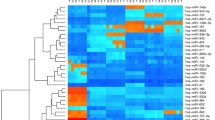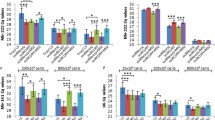Abstract
A systematic understanding of different factors influencing cell type specific microRNA profiles is essential for state-of-the art biomarker research. We carried out a comprehensive analysis of the biological variability and changes in cell type pattern over time for different cell types and different isolation approaches in technical replicates. All combinations of the parameters mentioned above have been measured, resulting in 108 miRNA profiles that were evaluated by next-generation-sequencing. The largest miRNA variability was due to inter-individual differences (34 %), followed by the cell types (23.4 %) and the isolation technique (17.2 %). The change over time in cell miRNA composition was moderate (<3 %) being close to the technical variations (<1 %). Largest variability (including technical and biological variance) was observed for CD8 cells while CD3 and CD4 cells showed significantly lower variations. ANOVA highlighted that 51.5 % of all miRNAs were significantly influenced by the purification technique. While CD4 cells were least affected, especially miRNA profiles of CD8 cells were fluctuating depending on the cell purification approach. To provide researchers access to the profiles and to allow further analyses of the tested conditions we implemented a dynamic web resource.







Similar content being viewed by others
References
Beliakova-Bethell N et al (2014) The effect of cell subset isolation method on gene expression in leukocytes. Cytometry A 85(1):94–104
Lyons PA et al (2007) Microarray analysis of human leucocyte subsets: the advantages of positive selection and rapid purification. BMC Genom 8:64
Leidinger P et al (2014) The blood-borne miRNA signature of lung cancer patients is independent of histology but influenced by metastases. Mol Cancer 13(1):202
Meder B et al (2011) MicroRNA signatures in total peripheral blood as novel biomarkers for acute myocardial infarction. Basic Res Cardiol 106(1):13–23
Leidinger P et al (2013) A blood based 12-miRNA signature of Alzheimer disease patients. Genome Biol 14(7):R78
Keller A et al (2009) Multiple sclerosis: microRNA expression profiles accurately differentiate patients with relapsing-remitting disease from healthy controls. PLoS One 4(10):e7440
Bloomston M et al (2007) MicroRNA expression patterns to differentiate pancreatic adenocarcinoma from normal pancreas and chronic pancreatitis. J Am Med Assoc 297(17):1901–1908
Roth P et al (2015) Differentially regulated miRNAs as prognostic biomarkers in the blood of primary CNS lymphoma patients. Eur J Cancer 51(3):382–390
Keller A et al (2014) Comprehensive analysis of microRNA profiles in multiple sclerosis including next-generation sequencing. Mult Scler 20(3):295–303
Joerger M et al (2014) Circulating microRNA profiling in patients with advanced non-squamous NSCLC receiving bevacizumab/erlotinib followed by platinum-based chemotherapy at progression (SAKK 19/05). Lung Cancer 85(2):306–313
Leidinger P et al (2014) What makes a blood cell based miRNA expression pattern disease specific?—a miRNome analysis of blood cell subsets in lung cancer patients and healthy controls. Oncotarget 5(19):9484–9497
Leidinger P et al (2014) The human miRNA repertoire of different blood compounds. BMC Genom 15:474
Griffiths-Jones S et al (2006) miRBase: microRNA sequences, targets and gene nomenclature. Nucleic Acids Res 34(Database issue):D140–D144
Backes C et al (2015) Prioritizing and selecting likely novel miRNAs from NGS data. Nucleic Acids Res. doi:10.1093/nar/gkv1335
Yu IW et al (2014) OpenArray profiling reveals no differential modulation of miRNA by positive and negative CD4+ T cell immunoselection. Exp Hematol 42(1):11–13
Kummerow C et al (2014) A simple, economic, time-resolved killing assay. Eur J Immunol 44(6):1870–1872
Friedländer MR et al (2012) miRDeep2 accurately identifies known and hundreds of novel microRNA genes in seven animal clades. Nucleic Acids Res 40:37–52
Benjamini Y, Hochberg Y (1995) Controlling the false discovery rate: a practical and powerful approach to multiple testing. J R Stat Soc Ser B Methodol 57(1):289–300
Acknowledgments
The work of AK, BM is supported by the European Union FP7 (BestAgeing). BM is grateful for support from the German Center for Cardiovascular Research (DZHK). We thank Elmar Krause for support within the FACS facility. We acknowledge funding by the Deutsche Forschungsgemeinschaft (DFG), the collaborative research centers SFB 1027 (Project A2 to MH) and SFB 894 (Project A1 to MH) and the research training group GK 1326 (to ECS and MH). We thank Stephanie Deutscher for excellent technical assistance.
Author information
Authors and Affiliations
Corresponding author
Additional information
E. C. Schwarz and C. Backes contributed equally as first authors.
Electronic supplementary material
Below is the link to the electronic supplementary material.
Supplemental Figure 1: log10 of mapped reads per sample, samples below the threshold of 0.5 million reads are highlighted
Supplemental Figure 2: RT-qPCR results for the same miRNAs as presented in Figure 7. The bar height corresponds to the pseudo counts as defined in the Methods
Supplemental Figure 3: Additional RT-qPCR validation experiments for three miRNAs. Left hand side presents the NGS results (panels A, C, E) while right hand side presents RT-qPCR based pseudo counts (panels B, D, F)
Supplemental Figure 4: Upper part shows the interface of the web resource with the example input CD3 positive selected vs. CD4 positive selected cells. Middle part presents a volcano plot of the analysis CD3 positive selected vs. CD4 positively selected, detailing the negative logarithm of the p-value vs. the logarithm of fold change. For the same comparison a scatter plot shows the logarithm of median expression for CD3 positive selected cells on the x-axis and for the CD4 positive selected cells on the y-axis. The hierarchical clustering of the 20 most significant miRNAs graphically demonstrates that the respective miRNAs are differentially regulated between both groups. The lower part presents the tabular output
Rights and permissions
About this article
Cite this article
Schwarz, E.C., Backes, C., Knörck, A. et al. Deep characterization of blood cell miRNomes by NGS. Cell. Mol. Life Sci. 73, 3169–3181 (2016). https://doi.org/10.1007/s00018-016-2154-9
Received:
Revised:
Accepted:
Published:
Issue Date:
DOI: https://doi.org/10.1007/s00018-016-2154-9




